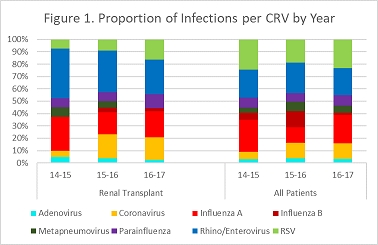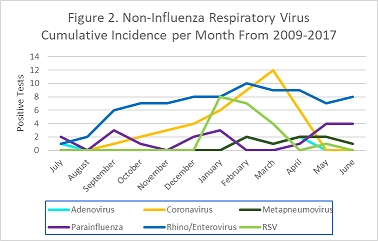Longitudinal Analysis of Community Respiratory Virus Infection in Kidney Transplant Recipients
O. Beaird, K. Phonphok, S. Chandrasekaran, O. Garner, S. Bunnapradist, J. Schaenman.
David Geffen School of Medicine, University of California, Los Angeles, Los Angeles, CA.
Meeting: 2018 American Transplant Congress
Abstract number: 137
Keywords: Infection, Kidney transplantation
Session Information
Session Name: Concurrent Session: Kidney Transplant Goes Viral
Session Type: Concurrent Session
Date: Sunday, June 3, 2018
Session Time: 4:30pm-6:00pm
 Presentation Time: 5:42pm-5:54pm
Presentation Time: 5:42pm-5:54pm
Location: Room 606/607
Purpose: Community respiratory viruses (CRVs) cause significant morbidity and mortality in solid organ transplant recipients, but little is known about the epidemiology of CRV infections in kidney transplant recipients (KTRs).
Methods: We analyzed retrospective data from KTRs who underwent respiratory virus testing (Simplexa Flu A/B & RSV PCR and/or GenMark eSensor respiratory viral panel PCR) at a large volume US transplant center (300-400 kidney transplants per year), from 2006-2017. Institutional microbiology data from 2014-2016 were used for comparison.
Results: There were 310/1481 (20.9%) positive tests in KTRs; 233 unique positives excluding duplicate/serial tests. Human rhinovirus (HRV) was the most common virus (n=82, 35.2%), followed by influenza A (n=47, 20.2%), coronavirus (CoV) (n=43, 18.5%), RSV and parainfluenza (PIV) (each 8.6%), human metapneumovirus (hMPV) (3.4%), influenza B (3%) and adenovirus (ADV) (2.5%). Viral co-detection occurred in 15 (6.4%) cases. The most common co-pathogens were HRV, CoV and PIV. Prolonged viral detection (>4 weeks) was seen with hMPV, CoV and HRV. The incidence of individual CRVs varied year-to-year, but seasonal patterns were similar between KTRs and the general population, with a trend towards higher rates of HRV and CoV, and lower rates of influenza B in KTRs (Figure 1). CRVs had temporal patterns in KTRs, with seasonal peaks of RSV, CoV and influenza A (Figure 2).
Conclusions: To our knowledge, this is the first study examining CRV epidemiology in KTRs. CRV trends were similar, but not identical to the general population. HRV and CoV were more frequent in KTRs. The impact of CRVs on allograft function and patient outcomes will be explored. These findings can be used to inform recommendations for PCR-based respiratory testing in KTRs.
CITATION INFORMATION: Beaird O., Phonphok K., Chandrasekaran S., Garner O., Bunnapradist S., Schaenman J. Longitudinal Analysis of Community Respiratory Virus Infection in Kidney Transplant Recipients Am J Transplant. 2017;17 (suppl 3).
To cite this abstract in AMA style:
Beaird O, Phonphok K, Chandrasekaran S, Garner O, Bunnapradist S, Schaenman J. Longitudinal Analysis of Community Respiratory Virus Infection in Kidney Transplant Recipients [abstract]. https://atcmeetingabstracts.com/abstract/longitudinal-analysis-of-community-respiratory-virus-infection-in-kidney-transplant-recipients/. Accessed December 28, 2025.« Back to 2018 American Transplant Congress


